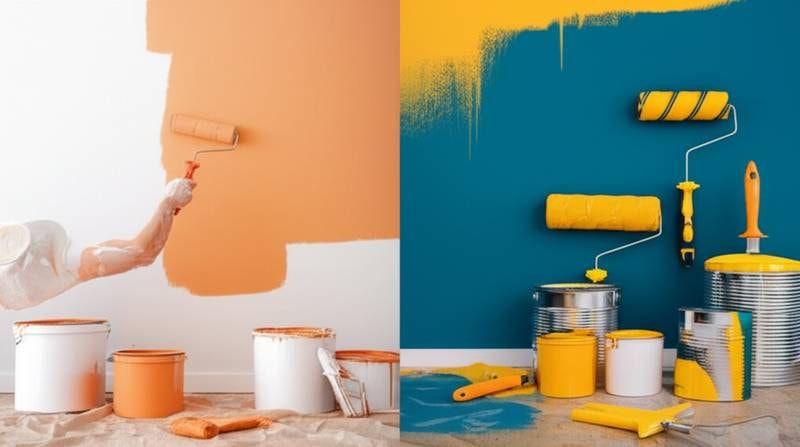The Hidden Costs of DIY Painting: Why Hiring Professionals Often Saves Money
Homeowners frequently view painting as a straightforward way to cut expenses. Purchasing paint and basic supplies seems far less costly than engaging a painting crew. However, escalating material prices, coupled with unforeseen outlays for errors or extended timelines, frequently demonstrate that professionals deliver greater value. Grasping the full scope of DIY versus professional expenses empowers informed choices for home improvement budgets.
Average Painting Cost Overview
Painting expenses fluctuate based on room dimensions, paint variety, surface readiness, and execution method. Homeowners typically encounter these price brackets:
Average Cost Ranges by Project Size
- Small room (up to 150 sq. ft.): $250 - $750
- Medium room (200-400 sq. ft.): $600 - $1,500
- Large room (400+ sq. ft.): $1,200 - $3,000
Cost Breakdown per Square Foot
Professional interior painting generally ranges from $2 to $6 per square foot, encompassing:
- Materials: $0.75 - $2 per square foot
- Labor: $1.25 - $4 per square foot
- Preparation: $0.50 - $1 per square foot
- Additional factors: $0.25 - $0.50 per square foot
DIY efforts might initially seem economical by limiting purchases to paint and essentials. Yet, investments in time, equipment, and corrections rapidly diminish those advantages.
Factors Affecting Painting Costs
Paint Quality
High-end paints, which provide superior coverage and longevity, range from $50 to $80 per gallon, exceeding basic varieties at $25 to $40. Professionals secure volume discounts unavailable to individuals, thereby balancing their service fees.
Preparation Work
Surfaces often require patching cracks, sanding imperfections, or applying primer. Novices commonly overlook the duration of these steps or possess inadequate tools, resulting in subpar adhesion. Experts incorporate comprehensive preparation within their pricing, promoting extended paint adherence.
Tools and Equipment
Essential items like brushes, rollers, ladders, protective cloths, masking tape, and sprayers accumulate $100 to $400 for beginners. Established crews maintain their own inventory, distributing expenses over numerous assignments.
Labor and Time
Self-directed efforts demand substantial personal hours, potentially spanning several weekends. Professional teams finish most jobs within days, yielding uniform outcomes. Evaluations of total cost must account for the monetary equivalent of that personal commitment.
Complexity of the Job
Elements such as vaulted ceilings, ornate molding, feature walls, or rough textures elevate difficulty. For amateurs, these features provoke inefficiencies, excess material use, and dissatisfaction. Trained specialists navigate such demands with precision and speed.
Detailed Cost Analysis by Category
| Category | DIY Range | Professional Range | Key Differences |
|---|---|---|---|
| Materials | $100 - $400 | $150 - $500 | Contractors access discounts on premium products |
| Tools/Equipment | $100 - $400 | Included in labor | DIY necessitates outright purchases or rentals |
| Labor/Time | Personal time | $1,000 - $2,500 | Pros ensure swift, reliable execution |
| Preparation | $50 - $200 | $200 - $600 | Experts perform detailed work that prolongs durability |
| Total Cost | $250 - $1,000 | $1,200 - $3,500 | DIY overlooks indirect expenses like time and rework |
Value and ROI Considerations
A fresh coat of paint ranks among the simplest methods to revitalize a residence and elevate market worth. Expert applications enhance exterior allure and attract prospective buyers more effectively. Although DIY approaches conserve initial funds, flawed execution diminishes aesthetic appeal and necessitates premature refreshes. Opting for skilled labor extends the job's viability by years, thereby lowering annualized expenses.
Money-Saving Strategies
Achieve quality results at reduced rates through targeted approaches:
- Manage basic preparation: Seal minor gaps or relocate furnishings prior to crew arrival, trimming billable hours.
- Select optimal paint grades: Opt for mid-tier formulas offering robust coverage without excessive premium pricing.
- Combine multiple areas: Executing several rooms concurrently distributes setup and mobilization charges.
- Time projects strategically: Arrange work during slower periods, such as late fall or winter, to negotiate favorable terms.
- Solicit competitive bids: Obtain estimates from at least three reputable firms to benchmark reasonable rates.
Planning Your Budget
Effective budgeting for painting incorporates:
- Paint and supplies: Calculate quantities using wall measurements and desired finish type.
- Labor costs: Seek itemized proposals from qualified providers.
- Contingency buffer: Allocate 10 to 15 percent for surprises like structural fixes or supplemental layers.
- Time value: Quantify the opportunity cost of self-labor against professional efficiency.
For extensive undertakings, explore payment plans or sequential room treatments to maintain progress without financial strain.
Frequently Asked Questions
1. What is the average cost for painting a room?
Most homeowners allocate $600 to $1,500 for a standard medium room with professional assistance. DIY expenditures vary from $250 to $600, influenced by material selections and tool requirements.
2. What factors have the biggest impact on painting costs?
Room scale, paint specifications, preparatory demands, and professional involvement exert the greatest influence on overall pricing.
3. How can I save money on painting without sacrificing quality?
Prioritize durable mid-range paints, perform straightforward prep tasks independently, and book during off-seasons. Consolidating rooms into a single engagement further optimizes expenses.
4. Should I hire professionals or attempt this as a DIY project?
Simple, compact spaces with basic surfaces suit DIY for modest savings. Complex setups, including tall elements or intricate details, benefit from expert intervention for superior speed and endurance.
5. How do I budget for unexpected costs in a painting project?
Reserve 10 to 15 percent of the total as a safeguard. Typical surprises encompass additional priming, unforeseen layers, or surface mending uncovered mid-process.
6. When is the best time to start a painting project for the lowest costs?
Target intervals of reduced contractor demand, such as non-summer months, to secure discounted rates and prompt scheduling.
Achieving Lasting Home Improvements
Balancing DIY enthusiasm with professional expertise ensures painting projects enhance your living space efficiently. By evaluating comprehensive costs and applying practical tactics, you secure vibrant, enduring results that align with your financial priorities and elevate property satisfaction.



